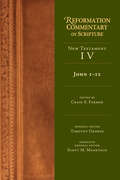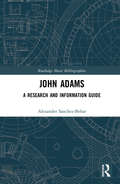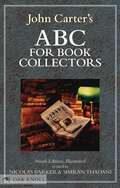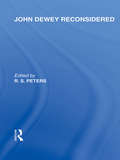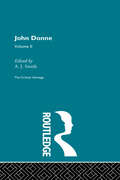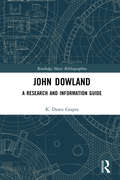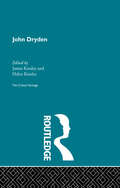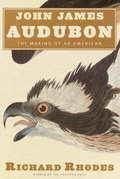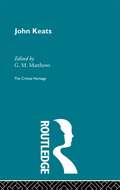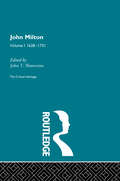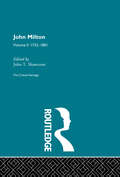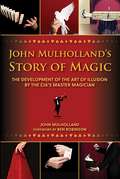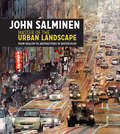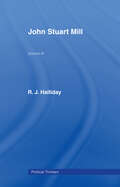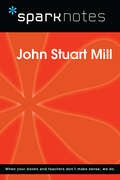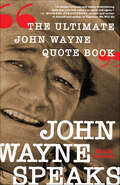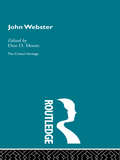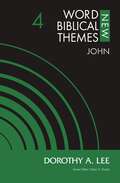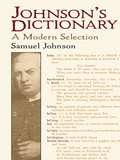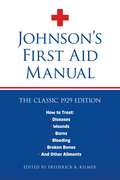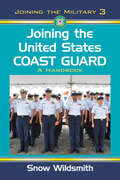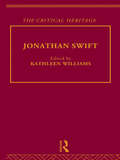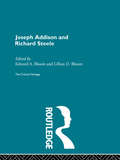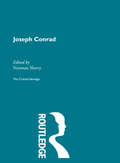- Table View
- List View
John Adams: A Research and Information Guide (Routledge Music Bibliographies)
by Alexander Sanchez-BeharJohn Adams: A Research and Information Guide offers the first comprehensive guide to the musical works and literature of one of the leading American composers of our time. The research guide catalogs and summarizes materials relating to Adams’s work, providing detailed annotated bibliographic entries for both primary and secondary sources. Covering writings by and interviews with Adams, books, journal articles and book chapters, newspaper articles and reviews, dissertations, video recordings, and other sources, the guide also contains a chronology of Adams’s life, a discography, and a list of compositions. Robust indexes enable researchers to easily locate sources by author, composition, or subject. This volume is a major reference tool for all those interested in Adams and his music, and a valuable resource for students and researchers of minimalism, contemporary American music, and twentieth-century music more broadly.
John Carter's ABC for Book Collectors
by John Carter Nicolas Barker Simran ThadaniThis ninth edition has been thoroughly revised and re-edited by Nicolas Barker, former Editor of The Book Collector, and Simran Thadani, Executive Director of Letterform Archive. With a new Introduction, it incorporates new terms, additions and amendments and, for the first time, illustrations in black & white and color. Nicolas Barker worked with his friend John Carter revising the ABC up to the latter's death in 1975 and has faithfully preserved the spirit of the original. ABC for Book Collectors, while keeping us up-to-date with modern terminology, retains its humorous character and importance as the one indispensable guide to book collecting.
John Dewey reconsidered (International Library of the Philosophy of Education Volume 19)
by R. S. PetersJohn Dewey was one of the most influential American philosophers of his time and also one of the most prolific, with about forty books and 700 articles to his credit. When this book was originally published in 1977 Dewey's work, with the exception of his important contributions to the philosophy of education, had suffered an unwarranted scholarly neglect and remained little known outside the USA. This present volume helped redress this balance.
John Donne: Volume II
by A.J. SmithContains writings about John Donne from 1873 to 1923, including Henry Morley, Edmund Gosse, W.F. Collier, Rudyard Kipling, Charles Eliot Norton, Henry Augustin Beers, Thomas Hardy, W.B. Yeats, Ezra Pound, T.S. Eliot, and many others. Together these works present a record of how, from the nineteenth century onwards, critics viewed Donne, and how he became part of today's literary canon.
John Dowland: A Research and Information Guide (Routledge Music Bibliographies)
by K. Dawn GrapesJohn Dowland: A Research and Information Guide offers the first comprehensive guide to the musical works and literature on one of the major composers of the English Renaissance. Including a catalog of works, discography of recordings, extensive annotated bibliography of secondary sources, and substantial indexes, this volume is a major reference tool for all those interested in Dowland's works and place in music history, and a valuable resource for researchers of Renaissance and English music.
John Dryden: The Critical Heritage (Oxford Standard Authors Ser.)
by James Kinsley Helen KinsleyThe Critical Heritage gathers together a large body of critical sources on major figures in literature. Each volume presents contemporary responses to a writer's work, enabling students and researchers to read for themselves, for example, comments on early performances of Shakespeare's plays, or reactions to the first publication of Jane Austen's novels.The carefully selected sources range from landmark essays in the history of criticism to journalism and contemporary opinion, and little published documentary material such as letters and diaries. Significant pieces of criticism from later periods are also included, in order to demonstrate the fluctuations in an author's reputation.Each volume contains an introduction to the writer's published works, a selected bibliography, and an index of works, authors and subjects.The Collected Critical Heritage set will be available as a set of 68 volumes and the series will also be available in mini sets selected by period (in slipcase boxes) and as individual volumes.
John Florio
by Hermann W. HallerA Worlde of Wordes, the first-ever comprehensive Italian-English dictionary, was published in 1598 by John Florio. One of the most prominent linguists and educators in Elizabethan England, Florio was greatly responsible for the spreading of Italian letters and culture throughout educated English society. Especially important was Florio's dictionary, which - thanks to its exuberant wealth of English definitions - made it initially possible for English readers to access Italy's rich Renaissance literary and scientific culture. Award-winning author Hermann W. Haller has prepared the first critical edition of A Worlde of Wordes, which features 46,000 Italian entries - among them dialect forms, erotic terminology, colloquial phrases, and proverbs of the Italian language. Haller reveals Florio as a brilliant English translator and creative writer, as well as a grammarian and language teacher. His helpful critical commentary highlights Florio's love of words and his life-long dedication to promoting Italian language and culture abroad.
John James Audubon: The Making of an American
by Richard RhodesAn award-winning author who has frequently explored science and American history offers the first major new biography in many years of ornithologist/artist John James Audubon (1785-1851). Rhodes traces Audubon's arrival in America from France, his (for a time) commuter marriage, and career culminating in his magnum opus The Birds of America. He presents a well-rounded portrait of the Audubon Society's namesake and the U. S. of the early frontier period. Illustrations include color plates of Audubon's celebrated watercolors of North American birds. Annotation ©2004 Book News, Inc. , Portland, OR (booknews. com)
John Keats: The Critical Heritage
by B. C. SouthamThe Critical Heritage gathers together a large body of critical sources on major figures in literature. Each volume presents contemporary responses to a writer's work, enabling students and researchers to read for themselves, for example, comments on early performances of Shakespeare's plays, or reactions to the first publication of Jane Austen's novels. The carefully selected sources range from landmark essays in the history of criticism to journalism and contemporary opinion, and little published documentary material such as letters and diaries. Significant pieces of criticism from later periods are also included, in order to demonstrate the fluctuations in an author's reputation. Each volume contains an introduction to the writer's published works, a selected bibliography, and an index of works, authors and subjects. The Collected Critical Heritage set will be available as a set of 68 volumes and the series will also be available in mini sets selected by period (in slipcase boxes) and as individual volumes.y
John Milton: The Critical Heritage Volume 1 1628-1731 (Studies In The English Renaissance Ser.)
by John T. ShawcrossFirst published in 1995. Routledge is an imprint of Taylor & Francis, an informa company.
John Milton: The Critical Heritage Volume 2 1732-1801 (Studies In The English Renaissance Ser.)
by John T. ShawcrossThe Critical Heritage gathers together a large body of critical sources on major figures in literature. Each volume presents contemporary responses to a writer's work, enabling students and researchers to read for themselves, for example, comments on early performances of Shakespeare's plays, or reactions to the first publication of Jane Austen's novels.The carefully selected sources range from landmark essays in the history of criticism to journalism and contemporary opinion, and little published documentary material such as letters and diaries. Significant pieces of criticism from later periods are also included, in order to demonstrate the fluctuations in an author's reputation.Each volume contains an introduction to the writer's published works, a selected bibliography, and an index of works, authors and subjects.The Collected Critical Heritage set will be available as a set of 68 volumes and the series will also be available in mini sets selected by period (in slipcase boxes) and as individual volumes.
John Mulholland's Story of Magic: The Development of the Art of Illusion by the CIA's Master Magician
by John MulhollandMagic has entranced public forums for hundreds of years, predating many other forms of entertainment that we enjoy today. This ancient art, with its captivating illusions and seemingly impossible sleight of hand, is still as relevant today as ever. Originally published in 1935, master magician John Mulholland’s Story of Magic is a delightful tour through the progression of magic, from its origin to the book’s contemporary period. It offers insights and reflections on famous routines and tricks, black-and-white photographs and illustrations to give readers visual reference, as well as informative facts that weave together a timeline of events for those interested in the history of magic. With a brand-new foreword written by renowned master magician and historian Ben Robinson, this timeless classic will enchant readers and educate them on the art of magic.
John Salminen - Master of the Urban Landscape: From realism to abstractions in watercolor
by John SalminenTake a Journey with the Master of the Urban Landscape! John Salminen is one of the most accomplished watercolor artists working today, earning awards and recognition all over the world. Whether depicting the trees of Central Park, the architecture of San Francisco or the busy streets of Beijing, John Salminen's watercolor paintings are snapshots of urban life that are both rich in detail and universal in appeal. In Master of the Urban Landscape, Salminen shares over 150 pieces of his artwork, spanning his entire career. His early abstracts and recent plein air work in the book's Introduction set the groundwork for four chapters of remarkable watercolor paintings that highlight different aspects of his work: architectural form, organic form, human form and light and shadow. Throughout, Salminen shares the inspiration for his paintings, challenges he encountered and techniques he used to capture unique scenes from cities around the world. Embark on an amazing watercolor journey with John Salminen—Master of the Urban Landscape. "John Salminen is a master of the medium of watercolor. His sense of light and design sets him apart from his contemporaries, and he has emerged as one of the finest living artists of our times with a style very much his own." --Dean Mitchell
John Stuart Mill
by R J Halliday R. J. HallidayFirst published in 1976, this volume offers a significant new interpretation of Mill's political thought, Mill's ambivalent attitude to democracy is carefully examined. The implications for modern democracy of Mill's views on consensus and leadership, bureaucracy and participation, equality and liberty emerge from a deep understanding of Mill's place in 19th century ideas.
John Stuart Mill (SparkNotes Philosophy Guide)
by SparkNotesJohn Stuart Mill (SparkNotes Philosophy Guide) Making the reading experience fun! SparkNotes Philosophy Guides are one-stop guides to the great works of philosophy–masterpieces that stand at the foundations of Western thought. Inside each Philosophy Guide you&’ll find insightful overviews of great philosophical works of the Western world.
John Wayne Speaks: The Ultimate John Wayne Quote Book
by Mark OrwollWith more than 1,100 impeccably sourced quotes from throughout John Wayne's 172-film career, John Wayne Speaks: The Ultimate John Wayne Quote Book provides what has often been missing from other Duke Wayne reference books: accuracy, context, and comprehensiveness.These quotations offer a deep dive into Wayne’s films and acting persona—the iconic American man of action whose sense of values and decency are a veneer covering a boiling pot of determination, courage, outrage, and even violence. The quotes in John Wayne Speaks are at once inspirational, humorous, touching, and revealing.Author and veteran journalist Mark Orwoll has created an overlay of categories into which each quote fits, making the manuscript easy for readers to find the type of quote—or even the exact quote, footnoted to identify its film—they may be searching for. But John Wayne Speaks is more than just a collection of the actor's movie lines. Orwoll has researched and written an in-depth introduction to Wayne's film career to put the quotes in a broader context. Movie-lovers will also appreciate the author's opinionated capsule reviews and production notes from Wayne's complete filmography.John Wayne Speaks is the quote book that every fan of the Duke needs and a delightful addition to any cinephile’s library.
John Webster: The Critical Heritage (Critical Heritage Ser.)
by Don D. MooreThe Critical Heritage gathers together a large body of critical sources on major figures in literature. Each volume presents contemporary responses on a writer's work, enabling student and researcher to read the material themselves.
John, Volume 4 (New Word Biblical Themes: New Testament)
by Dorothy A. LeeVolumes in New Word Biblical Themes: New Testament series offer short, accessible studies of the key themes of each book of the New Testament.Each volume offers an introduction to the book, a brief exposition of the text with its basic background and a survey of its contents, an overview of its themes, and a deeper look at 3-5 key themes for understanding the book and for preaching and teaching.
Johnson's Dictionary: A Modern Selection
by Samuel Johnson George Milne E. L. McAdamWritten virtually single-handedly over a seven-year period by a revered dean of English letters, Johnson's Dictionary first appeared in 1755. A remarkable monument to the vigor and variety of our language and to the genius of its author, it served as the standard dictionary for more than 150 years and formed the basis for all subsequent English dictionaries. This modern version reduces the original 2,300 pages of definitions and literary examples to a more manageable length, retaining the verbal pleasure and historical curiosity of the original. It features many entries that can no longer be found in most modern dictionaries, with intriguing definitions and examples of usage in the literature of Johnson's time.
Johnson's First Aid Manual
by Frederick KilmerThe classic 1929 guide to first aid by a household name in America.
Joining the United States Coast Guard: A Handbook (Joining the Military #3)
by Snow WildsmithThis book is for the teenager or young adult who is interested in enlisting in the United States Coast Guard. It will walk him or her through the enlistment and recruit training process: making the decision to join, talking to recruiters, getting qualified, preparing for basic training, and learning what to expect at basic recruit training. The goal is to help young people who might be curious about serving in the Coast Guard decide if it is right for them, if they are qualified for and prepared for it and if the Navy, Army or Marine Corps would be a better fit.
Jonathan Swift: The Critical Heritage (Critical Heritage Ser.)
by Kathleen WilliamsThe Critical Heritage gathers together a large body of critical sources on major figures in literature. Each volume presents contemporary responses to a writer's work, enabling student and researcher to read the material themselves.
Joseph Addison and Richard Steele: The Critical Heritage
by Lillian D. Bloom Edward A. BloomFirst Published in 1995. Routledge is an imprint of Taylor & Francis, an informa company.
Joseph Conrad: A Commemoration (The\cambridge Edition Of The Works Of Joseph Conrad Ser.)
by Norman SherryJoseph Conrad (1857-1924). Polish born, learnt English from scratch when he arrived in Britain. Writings include: Heart of Darkness, The Secret Agent, Nostromo. Volume covers the period 1895 - 1993. Includes Conrad's responses to his critics.
